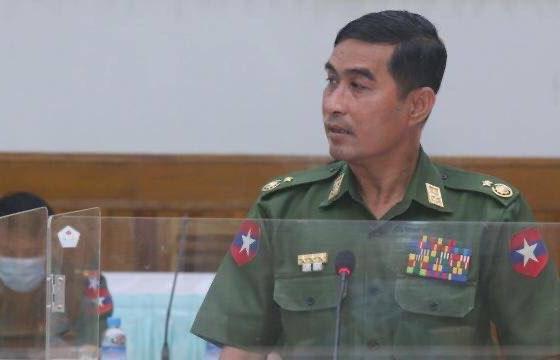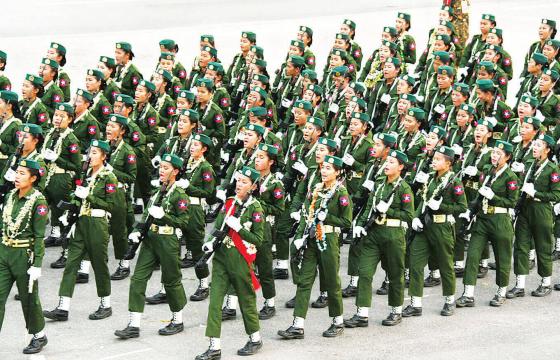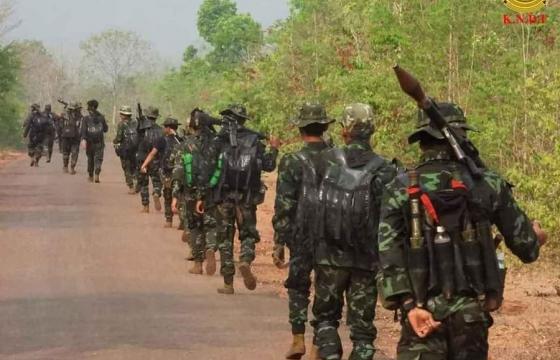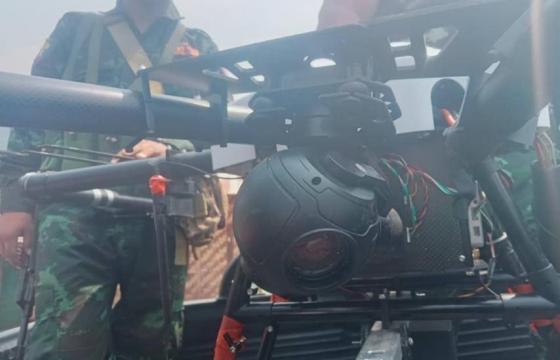As the constitutional amendment joint committee focusing on constitutional reform which was formed with 45 members are going to meet and program development aimed at submitting the result in July will be carried out, the NLD and military bloc definitely will be gearing up to make their positions known in the forthcoming amendment process procedure.
Reportedly, parliament approved a motion on February 19 to include 45 lawmakers on the panel, including 19 from the ruling National League for Democracy (NLD) party, 8 from the military, 2 USDP, 3 Arakan National Party (ANP), 2 Shan Nationalities League for Democracy (SNLD), and 11 legislators from other parties.
In this respect, the ethnic nationalities bloc, altogether 13 Ethnic Political Parties (EPPs) MPs (ANP 3; SNLD 2; Ta’ang 1; Zomi 1; Pa-O 1; Lisu 1; Kokang 1; Mon 1; Wa 1; Kachin 1) are tasked with the duty to make their forefathers aspirations known and continue to realize their ideals. Otherwise, the amendment of 2008 military-drafted constitution itself will imply that the ethnic nationalities accept the charter without question, which would in turn means the acceptance of nullifying the 1947 Panglong Agreement, 1947 Union of Burma Constitution and 1961 Federal Amendment Proposal of all ethnic nationalities, which are the three core historical documents in the making of Union of Burma or Myanmar in 1948.
It should be noted though that the recently employed constitutional amendment process and also the 21st Century Panglong Conference are all aimed at doing away with the three historical treaties or documents mentioned, intentionally or unintentionally, by the successive Bamar-dominated governments in the aftermath of the 1962 military coup, which is not at all in the interest of the ethnic nationalities.
From the ethnic nationalities point of view, these mentioned three historical documents are irrevocable as they are parts of the voluntary agreement signed in Panglong on February 12, 1947, which is the sole legal bond that binds the then known as Chin and Kachin Hills; Federated Shan States; and Ministerial Burma or Burma Proper represented by the late Gen Aung San of Burma’s Interim Anti-Fascist People’s Freedom League (AFPFL) government. Burma Proper then covered Karen, Mon and Arakan areas not yet recognized as ethnic states, which technically should be taken as having being involved in the signing of Panglong Agreement, except the Karenni State which was independent and didn’t sign the Panglong treaty.
Therefore, it goes without saying that ever since the the 1962 military coup and nullification of 1947 Panglong Agreement and 1947 Union of Burma Constitution, the Union of Burma established in January 1948 is no more in existence. Thus it could be taken in a legal sense that the treaty between the Bamar State and the ethnic States as being abolished due to the breaching of 1947 Panglong Agreement or treaty between the Bamar and the ethnic States by the then Bamar military government. The country that we called Myanmar today is only a forced union and not comparable to the voluntary union which was built in 1948.
What is exactly our forefathers’ dreams and aspirations?
No doubt, it is a genuine federal union to put it generally. To be specific it is an ethnic-territorial-based federalism, which generally is anchored in 8 ethnic states system, namely: Kachin, Shan, Karenni, Karen, Mon, Arakan, Chin and Burma or Bamar states. However, the demarcation of the Bamar state was never actually realized as the successive Bamar-dominated governments usurped political power under the union government cloak and replaced the British colonial master position. This hegemony and unjustified power usurpation remains today and is the unending continuation source of ethnic conflict.
It should be noted that the 1962 military coup took place with the argument that federalism equals disintegration of the country. The 1962 parliamentary debate on federal amendment proposal spear-headed by the Shan State government was in fact the last legal resort to find political solution to the flaws of 1947 Union of Burma Constitution, which was only “federal in theory but unitary in practice,” as remarked by U Chan Htun the drafter of the constitution according to Hugh Tinker, the most quoted historian on Burma.
What exactly was proposed in 1962?
In 1961 the Shan State government produced a resolution widely known as “The Shan Federal Proposal” that was a legally-based initiative to try and right the obvious weaknesses in the 1947 constitution. This proposal was unanimously adopted by the Shan State government on 24 January 1961 and subsequently endorsed by delegates, all of whom were non-Bamar, at the All States Conference on 16 June 1961 in Taunggyi. Following the resolution, the All States Unity Organization was formed by the conference, with Kachin, Karenni, Karen, Chin, Arakan, Shan and Mon as members.
To amend the 1947 constitution, a key part of the federal proposal reads:
The provisions for equal rights and opportunities between the various states and nationalities are not adequately prescribed in the present Constitution of the Union of Burma.
The Steering Committee has therefore unanimously decided that to ensure equal rights and opportunities for all, the Constitution should be revised in accordance with the principles of a truly federal constitution.
The Steering Committee hereby resolves that in redrafting the Constitution, in accordance with genuine federal principles, the following basic requirements for ensuring equality shall be included:
1 Establishment of a Burmese (Bamar) State;
2 Assignment of equal powers to both Chambers of the Union Parliament;
3 Each State to be represented by an equal number of representatives in the Chamber of Nationalities;
4 The following Departments shall be vested in the Central Union, while all other powers, rights and entitlements shall be transferred to the states.
(a) Foreign Affairs;
(b) Union Defense;
(c) Union Finance;
(d) Coinage and Currency;
(e) Posts and Telegraphs;
(f) Railways, Airways and Waterways;
(g) Union Judiciary;
(h) Collection of Custom duties at Seaports.
5 Union revenue to be distributed equitably.
Of the five basic requirements, the first needs a little more clarification: the creation of a Burmese or Bamar State. The All States Unity Organization’s document on the Federal Amendment Proposal, which was presented to U Nu in January 1962 by ethnic leaders prior to a forthcoming national conference, noted that the 1947 constitution had a fundamental problem. Prior to independence, “Burma Proper” was one element in a diarchic system of government under colonial government whereby parliamentary home rule was introduced among the Bamar majority in what became known as “Ministerial Burma”, while the non-Bamar peoples of the Frontier Areas were largely left under their traditional leaders and rulers. It was only at independence in 1948 that the two territories were constitutionally combined. However, instead of the administration of Burma Proper having a separate state government for itself, under the 1947 constitution it had come to serve as the central government as well. This meant not only a usurpation of the central powers of the government by Bamar-majority politicians in the former Burma Proper but also that the political rights of the non-Bamar territories and peoples were mostly denied. (Source: Jump-starting the stalled peace process Is Revitalization of the 1961 Federal Amendment Proposal the Way to Go? TNI Publication – 04 May 2017)
Federalism as seen by Bamar political class and military
In a nutshell the military understanding of federalism is based on its self-drafted 2008 constitution and believed, rightly or wrongly, a few alteration of some clauses in the charter would lead to a genuine federal union. But as all knows it is a unitary system with strong central control and won’t lead to a real democratic federal system. Thus it could be taken as only an attempt to continue the unitary system with some federal trappings, dominated by the military and Bamar political class.
As for the NLD, it has never spelled out its federalism outlook transparently other than saying that it will adhere to the outcome of 21st Century Panglong Conference, which has been halted since last November, as the two most influential Nationwide Ceasefire Agreement-signatory EAOs opted out of the negotiation process, citing unfairness, until today.
What the EPPs should consider or propose
Precisely, first the EPPs should aim for the ethnic-territorial-based federalism like their forefathers had agreed upon from the outset. It is true that there could be a more refined and innovative federal system that could be incorporated into it, such as regulating the sub-ethnic groups desire for more say in each ethnic state, but such a theoretical debate and probable solutions should be handled in a different forum or setting.
Secondly, the EPPs should hold the three historical documents of 1947 Panglong Agreement, Union of Burma Constitution and the 1961 federal amendment proposal dearly to their heart and apply them in whatever political bargaining they will encounter, as their guiding principles. Because without these historical documents they won’t be able to assert their historical and ethnic rights effectively and will merely become pawns between the Bamar political elite and Bamar-dominated military class political struggle for supremacy.







